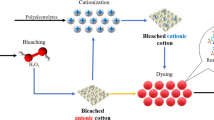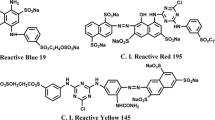Abstract
Cationization of cotton fabrics was performed utilizing 3-chloro-2-hydroxypropyltrimethylammonium chloride (CHPTAC) in a cold pad batch procedure. Cotton fabrics were cationized at three levels 2.11, 4.23, and 8.45 % on weight of fabric of CHPTAC. Different neutralization schemes were employed on each cationization level to determine the effect of pH and process parameters on minimizing the amount of free trimethyl amine (TMA) in cationized cotton. Employing a solvent extraction method and gas chromatography/flame ionization detection (GC/FID), TMA was extracted and determined in parts per million (ppm) from the neutralized and sealed and aged cationized fabric. The results show that it is straightforward to quantify the concentration of TMA in cationized fabric and that the lowest levels of TMA in cationized cotton are achieved with by an initial warm rinse to remove excess sodium hydroxide, followed by acidification bath to achieve an acidic pH, and ending with a subsequent cold final rinse.







Similar content being viewed by others
References
Choudhury AK (2014) Coloration of cationized cellulosic fibers: a review. AATCC J Res 3:11–19
De Vries TS, Davies DR, Miller MC, Cynecki WA (2014) Kinetics of the cationization of cotton. Ind Eng Chem Res 53:9686–9694
Farrell MJ (2011) Sustainable cotton dyeing. Dissertation, North Carolina State University
Farrell MJ, Hauser PJ (2013) Cationic cotton, reservations to reality. AATCC Rev 9(10):56–63
Farrell MJ, Ankeny MA, Hauser PJ (2014) Prediction of recipes for cotton cationisation and reactive dyeing to shade match conventionally dyed cotton. Color Technol 130:363–367
Fu S, Hinks D, Hauser P, Ankeny M (2013) High efficiency ultra-deep dyeing of cotton via mercerization and cationization. Cell 20:3101–3110
Hashem M, Hauser P, Brent Smith (2003) Reaction efficiency of for cellulose cationization using 3-chloro-2-hydroxypropyl trimethyl ammonium chloride. Text Res J 73:1017–1023
Hauser PJ, Tabba AH (2001) Improving the environmental and economic aspects of cotton dyeing using a cationised cotton. Color Technol 117:282–288
Rupin M (1976) Dyeing with direct and fibre reactive dyes. Text Chem Colorist 8:54–58
Tarbuk A, Grancaric AM, Leskovac M (2014a) Novel cotton cellulose by cationisation during the mercerization process—part 1: chemical and morphological changes. Cell. doi:10.1007/s10570-014-0245-z
Tarbuk A, Grancaric AM, Leskovac M (2014b) Novel cotton cellulose by cationisation during the mercerization process—part 2: the interface phenomena. Cell. doi:10.1007/s10570-014-0194-6
Yuan H, Hauser PJ (2014) Synthesis of a bi-functional cationic agent and its application in cotton dyeing. AATCC J Res 2:8–12
Author information
Authors and Affiliations
Corresponding author
Rights and permissions
About this article
Cite this article
Farrell, M.J., Ormond, R.B. & Gabler, W.J. Quantitative analysis of trimethyl amine in cotton fabrics cationized with 3-chloro-2-hydroxypropyltrimethylammonium chloride. Cellulose 22, 3435–3439 (2015). https://doi.org/10.1007/s10570-015-0692-1
Received:
Accepted:
Published:
Issue Date:
DOI: https://doi.org/10.1007/s10570-015-0692-1




